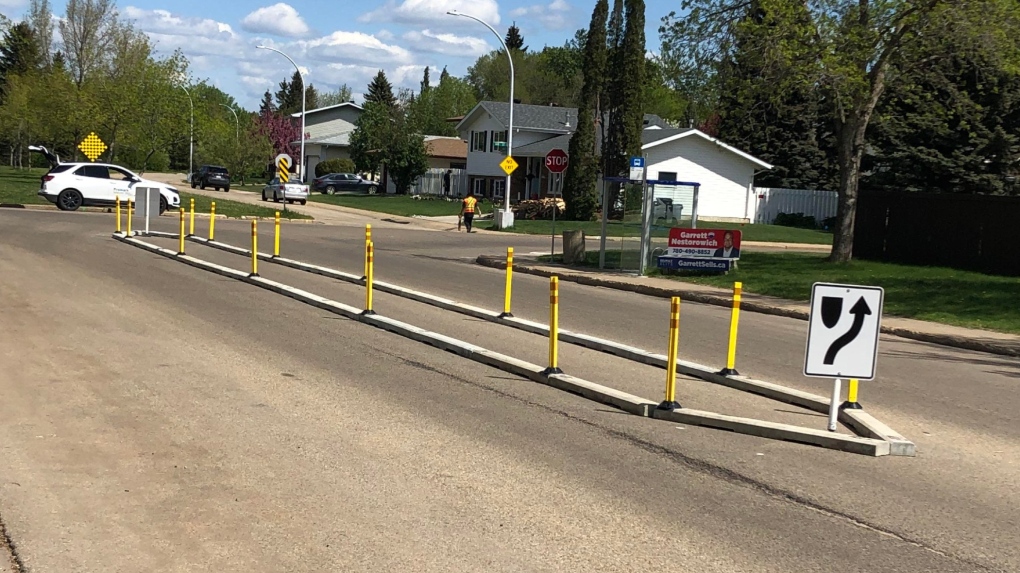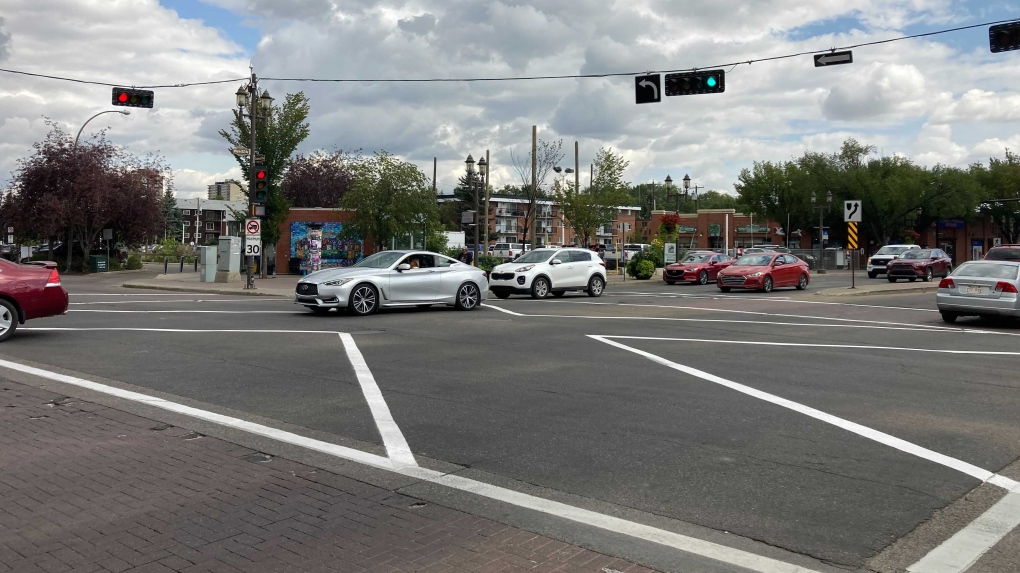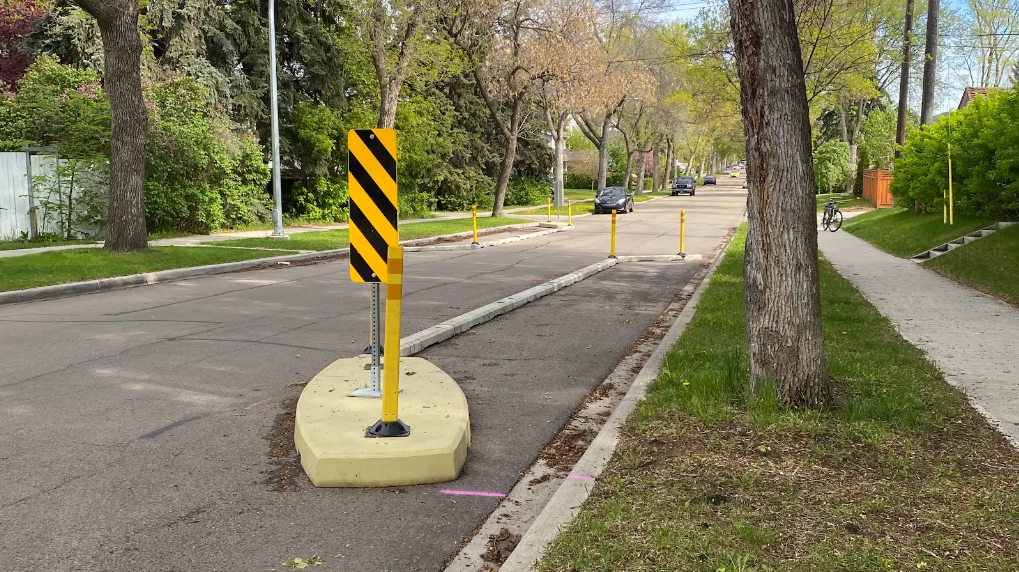Photo radar restrictions, bad behaviour among roadblocks for Edmonton's 2032 goal for zero traffic-related deaths
 Two-stage crossings are one of the traffic-calming measures used by the City of Edmonton to make travelling in the city safer. (The City of Edmonton)
Two-stage crossings are one of the traffic-calming measures used by the City of Edmonton to make travelling in the city safer. (The City of Edmonton)
The City of Edmonton is committed to reaching zero traffic fatalities in the next seven years, despite barriers including photo radar restrictions and the power of personal choice.
Since Edmonton adopted Vision Zero, an internationally recognized traffic safety strategy, in 2015, fatalities and serious injuries have been on a downward trend.
Between 2015 and 2022, traffic-related deaths dropped by 56 per cent, with a 67 per cent drop in pedestrian fatalities, city data shows.
Then, the number of people killed in crashes spiked to 24 in 2023.
Things are looking grim again this year, with 15 people killed between January and July and numbers likely to rise, as winter is statistically the most dangerous time for pedestrians.
The rise in road fatalities comes at a time when the city faces increasing financial pressure and the potential loss of millions more in enforcement-related traffic-safety funding.
Still, there's hope from advocates and officials that Edmonton's 2032 target remains realistic – if everyone can get on board.
"Does it make it feel like 2032 is tougher to reach? Of course," said Jessica Lamarre, director of safe mobility at the city of Edmonton. "I do think it's going to take more commitment than we've already shown in the city."
"I think it's achievable," said Shannon Lohner, chair of advocacy group Paths for People. "However, [city council is] going to need to prioritize investment in it."
"They have got to make this a huge priority in order to make this a reality."
'A crisis'
The year Edmonton adopted Vision Zero, 32 people were killed in crashes, including 12 pedestrians.
"Our fatalities and serious injuries were at an all-time high in the city and it became a bit of a crisis," Lamarre said.
The Vision Zero strategy uses engineering, education and enforcement to mitigate or remove traffic dangers, with the end goal being to eliminate traffic-related fatalities and serious injuries.
"Are we ever going to get to a place where there's never a fender bender? Of course not," Lamarre said. "But we never want someone's life to be tragically and irreversibly impacted because they went to the grocery store."
 Centre medians are one of the traffic-calming measures used by the City of Edmonton to make travelling in the city safer. (The City of Edmonton)
Edmonton's work has included lowering the default speed limit, upgrading more than 500 crossings – including adding the city's first scramble crosswalks – and piloting traffic-calming measures like speed humps and curb extensions, projects known as "street labs."
Centre medians are one of the traffic-calming measures used by the City of Edmonton to make travelling in the city safer. (The City of Edmonton)
Edmonton's work has included lowering the default speed limit, upgrading more than 500 crossings – including adding the city's first scramble crosswalks – and piloting traffic-calming measures like speed humps and curb extensions, projects known as "street labs."
According to Lamarre, in the two years since the city lowered the default speed limit to 40 km/h, those roads have seen 25 per cent fewer crashes and 31 per cent fewer injuries and deaths.
"When we told people that slower is safer, we meant it."
'Choices people are making'
Paths for People wants the city to further lower the default speed limit and invest more money into large-scale traffic calming measures.
The group also wants to see Edmonton's Complete Streets Design and Construction Standards updated to ensure future city planning is done with Vision Zero in mind.
"It's really difficult to incentivize developers to actually build safe streets because they take up way more room," Lohner said. "We're kind of stuck in a little bit of a trap where we are working off of outdated standards that don't fit for the types of communities that we want to build."
Good traffic design can account for some common mistakes, as exemplified by scramble crosswalks on streets with high volumes of vehicle and pedestrian traffic.
"It's just a lot for the driver to manage," Lamarre said. "So in those situations … we should all only move when it's the safest to move, and that will reduce those conflicts."
 A scramble crosswalk can be seen on Whyte Avenue at Gateway Boulevard on Aug. 19, 2021. (CTV News Edmonton)Both Lohner and Lamarre pointed out there's only so much the city can plan for.
A scramble crosswalk can be seen on Whyte Avenue at Gateway Boulevard on Aug. 19, 2021. (CTV News Edmonton)Both Lohner and Lamarre pointed out there's only so much the city can plan for.
"Having people irresponsibly driving across the city is a huge hindrance to Vision Zero," Lohner said.
"A traffic engineer cannot control if someone decides to drive under the influence," Lamarre said. "Or if someone decides to drive at 150 km/h … Those are choices people are making that have really tragic outcomes."
Photo radar restrictions
City data shows 57 per cent of fatal crashes last year involved excessive speed, or more than 20 km/h over the speed limit.
"There are laws and rules and some people comply and some people won't. And enforcement is one of the ways to get at that issue," Lamarre said.
Edmonton's automated enforcement includes red light cameras and photo radar, with all revenue from fines used to fund traffic safety initiatives.
Those tools are becoming increasingly limited, Lamarre said, after the province put a freeze on new photo radar equipment and locations in 2019 and banned it on Anthony Henday Drive last December.
"As a result of those restrictions, many, many millions of revenue have been eliminated," Lamarre said.
Between 2015 and 2018, the city averaged around $46 million in automated enforcement fines. Last year, it brought in just over $29 million.
Further restrictions to automated enforcement are expected in December, including limiting photo radar to construction, school and playground zones.
"What that means," Lamarre said, "is rather than folks who are paying fines through enforcement for having broken the law, the work of traffic safety improvement has been passed on [to the tax base]."
Among other changes, the city will lose the ability to issue speeding tickets at red light cameras.
The City of Edmonton's 2023 Automated Traffic Enforcement Report shows crashes at the Whitemud Drive-111 Street intersection dropped from an annual average of 12 to five after an automated enforcement camera was installed in 2018.
"These tools have been proven to work," Lohner said. "But the city effectively has their hands tied."
Transportation minister Devin Dreeshen says his office has been working with municipalities and police over the summer to "get rid of photo radar 'fishing holes.'"
"The province wants to ensure photo radar is used for traffic safety rather than revenue generation," Dreeshen said.
The new approved locations are expected to be finalized by the end of the year, Dreeshen said, with the focus on "sensitive areas" like school, playground and construction zones.
The Alberta Association of Chiefs of Police (AACP) believes the loss of automated enforcement will reduce road safety and negatively impact police efforts and Alberta drivers.
"Police will be required to increase in-person enforcement to address community concerns," the AACP said in a statement. "This not only reduces police capacity to deal with other important safety priorities but will also result in drivers receiving not only the fine, but also demerit points on their licence.
"This can have impacts on insurance costs, as well as the potential of driving privileges being suspended for repeat offences."
Culture shift
Traffic safety improvements are not convenient, Lamarre said, because they're meant to slow you down.
"Understandably, that annoys people to some extent," she added. "When we started putting these (traffic-calming measures) in there was quite a bit of pushback around these things.
"But now, as more and more people have experienced them, the desire to have them in their own neighborhood has grown."
Lohner said "significant progress" has been made in Edmonton and she's glad to see more neighborhoods welcoming those often inconvenient measures.
 Curb extensions are a traffic-calming measure that help reduce the time pedestrians and cars need to share the road. They are one of the traffic-calming measures used by the City of Edmonton to make travelling in the city safer. (The City of Edmonton)
However, there's much work left to do to reach what she calls a "pretty ambitious" 2032 target.
Curb extensions are a traffic-calming measure that help reduce the time pedestrians and cars need to share the road. They are one of the traffic-calming measures used by the City of Edmonton to make travelling in the city safer. (The City of Edmonton)
However, there's much work left to do to reach what she calls a "pretty ambitious" 2032 target.
"We really need to be pushing these conversations forward. We need to be getting more funding into these programs," Lohner said.
"We have steps that we can take. We have things that we can do. We just really need to prioritize funding and actually getting the infrastructure in place."
Lamare said, despite financial strain, the city increased Safe Mobility's budget to $27 million for 2025.
That money will go in part toward 250 crosswalk upgrades before the end of 2026, as well as traffic safety street labs in 14 neighbourhoods this fall.
Work is also underway to update street design standards, but she doesn't know when that is expected to be complete.
CTVNews.ca Top Stories

Stunning photos show lava erupting from Hawaii's Kilauea volcano
One of the world's most active volcanoes spewed lava into the air for a second straight day on Tuesday.
Richard Perry, record producer behind 'You're So Vain' and other hits, dies at 82
Richard Perry, a hitmaking record producer with a flair for both standards and contemporary sounds whose many successes included Carly Simon’s 'You’re So Vain,' Rod Stewart’s 'The Great American Songbook' series and a Ringo Starr album featuring all four Beatles, died Tuesday. He was 82.
Read Trudeau's Christmas message
Prime Minister Justin Trudeau issued his Christmas message on Tuesday. Here is his message in full.
What is flagpoling? A new ban on the practice is starting to take effect
Immigration measures announced as part of Canada's border response to president-elect Donald Trump's 25 per cent tariff threat are starting to be implemented, beginning with a ban on what's known as 'flagpoling.'
Hong Kong police issue arrest warrants and bounties for six activists including two Canadians
Hong Kong police on Tuesday announced a fresh round of arrest warrants for six activists based overseas, with bounties set at $1 million Hong Kong dollars for information leading to their arrests.
Dismiss Trump taunts, expert says after 'churlish' social media posts about Canada
U.S. president-elect Donald Trump and those in his corner continue to send out strong messages about Canada.
Indigenous family faced discrimination in North Bay, Ont., when they were kicked off transit bus
Ontario's Human Rights Tribunal has awarded members of an Indigenous family in North Bay $15,000 each after it ruled they were victims of discrimination.
Heavy travel day starts with brief grounding of all American Airlines flights
American Airlines briefly grounded flights nationwide Tuesday because of a technical problem just as the Christmas travel season kicked into overdrive and winter weather threatened more potential problems for those planning to fly or drive.
King Charles III is set to focus on healthcare workers in his traditional Christmas message
King Charles III is expected to use his annual Christmas message to highlight health workers, at the end of a year in which both he and the Princess of Wales were diagnosed with cancer.

































